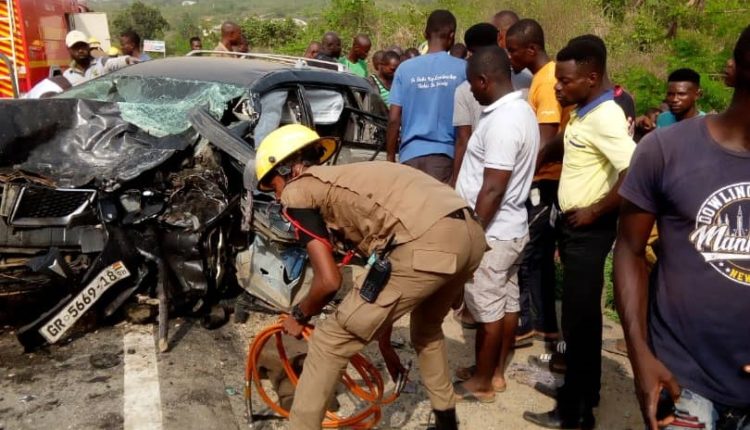According to the World Health Organization (WHO), approximately 1.35 million people die each year as a result of road crashes. Narrowing it down to Ghana, figures from the National Road Safety Authority (NRSA) indicate that in 2015, 1,820 people lost their lives, whilst 2,840 died in 2016. The MTTD recorded 2,341 deaths in 2018 with almost 800 of them being casualties of knock-downs.
These numbers exclude those who have been injured, maimed and even lost somebody function, and often, these are even more than the fatalities.
These numbers may seem random, almost surreal until someone close to you becomes a victim; could be your father, sister, brother or mother or even child. These are human lives, relatives, often breadwinners.
The most recent road crash, on the dawn of January 14, 2020, which claimed the lives of 35 people while 57 others suffered various injuries at Dompoase near Elmina in the Central Region convinced me that considerably, more attention needs to be given to the issue of safety on our roads.
Road safety should by now become a national conversation. The absence of road traffic signs, the state of vehicles on the road, the negligence of authorities to enforce road safety regulations, as well as drivers and pedestrians’ inattentiveness to road markings and warnings are some of the main contributory factors to road crashes.
It is undeniable that the transportation system of any country significantly improves the standard of the people living there depending on how efficient it is. However, in Ghana, although it is expected to contribute to economic growth, it is gradually and rather, unfortunately, becoming the most harmful element of our daily lives.
The thing about losses from road crashes is that, unlike illnesses, victims of road crashes or their families and loved ones don’t get to prepare for their deaths. As a result, the emotional pain and the sense of loss become unbearable.
Pedestrian deaths and the completed Madina-Adenta footbridges
One aspect of these road-related deaths that has not been given much emphasis is pedestrian knockdowns. Indeed, the Road Safety Authority according to 2016 figures said: “the road user class with the highest share of fatalities continued to be pedestrians at 824.” This is due to a number of factors, chief among them being indiscipline or poor attitude by road users.
The Madina-Adenta highway, until very recently, was notorious for this particular kind of incident, pedestrian knockdowns. The areas spanning both towns, Madina and Adenta, are densely populated, resulting in a much larger volume of pedestrian traffic across the highway. One would think that this should push both drivers and pedestrians to exercise a lot more caution when using the road, but that has not been the case.
In November 2018, a young student of the West African Senior High School was killed by a speeding vehicle on that stretch. This sparked public outrage causing the residents to block the highway in protest. They called on the authorities to complete the six footbridges on the stretch to ensure that the student’s life was one of the last lost in such a manner.
Being a resident of Adenta myself, these deaths hit me much harder than I would admit. When I moved there in 1999, that stretch of the road was in a very bad state, until it was reconstructed into the almost flawless highway it is now. Since then, many drivers have abandoned caution, using the road as though they were the only ones on it, ignoring speed limits, traffic lights, zebra crossings and even sometimes the police.
With lots of junior and senior high schools dotted along that stretch, it raised issues of how the road could be safer for users. The government took steps to complete the footbridges, giving the contractors working on them six months to get them done. To their and everyone else’s surprise, the residents who vigorously demanded these footbridges, literally fighting for them, have refused to use them, citing various flimsy reasons. They still prefer to cross the road at unauthorized places putting their lives and that of drivers who ply the road daily in danger.
In an attempt to clamp down on this level of indiscipline, the police conducted operations along the stretch, arresting a number of these recalcitrant pedestrians who were then prosecuted, but even the police seem to have thrown in the towel, and the phenomenon still persists. Now the question that runs through my mind is, why were the residents protesting to get the footbridges completed?
Was it a kneejerk reaction to the student’s death? Were they trying to make the government unpopular? Or was it a genuine concern for their lives and others’? On the basis of what we’ve observed since the latter reason seems increasingly unlikely.
Conclusion
If traffic laws on drink-driving, seat-belts, speed limits, helmets, pedestrian crossings, amongst other things are not enforced, they cannot bring about the expected reduction in road traffic fatalities and injuries. Governments need to take action to address road safety in a holistic manner by involving multiple sectors such as transport, police, health, education, and actions that address the problem, for losing over two thousand people to road-related deaths in a year is not smart.
Now that the National Road Safety watchdog has been upgraded to an authority status with more biting powers like the prosecution of culprits who violate road safety regulation, it has to be adequately resourced to undertake intensive public education and be seen to be delivering on its mandate.
The education must go hand-in-hand with enforcement of road traffic regulations, it is only then that the sector can be reformed.
The author, Ann-Shirley Ziwu, is a broadcast journalist with Citi FM and Citi TV


Comments are closed.